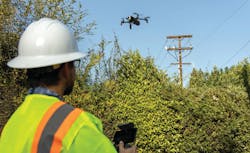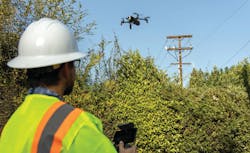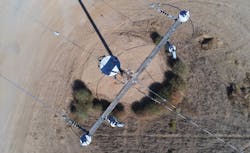Drones Survey Power Lines in High-Risk Fire Areas
If you combine the states of New York, Delaware and Rhode Island, then you would have an area roughly the size of the total service territory of 50,000 square miles for Southern California Edison (SCE). And all the electrical equipment throughout this area needs to be inspected regularly.
In areas designated by the state as having a high risk for wildfires, SCE has poles, transformers and lines that number about 400,000. To inspect this equipment for any needed repairs, the utility uses foot patrol crews, trucks and helicopters. And now you can add drones to this list of tools.
“We are trying to mobilize every asset we have to get power back on quickly and safely. And that includes drones,” says Tom Guntrip, SCE director of Transportation Services, who noted that drones can be deployed locally, especially in rural and mountainous areas. “Drones have to be part of our arsenal of tools.”
Investing in Drones
In 2015, SCE bought its first drone. Now, it has 20 drones with high-tech capabilities, including infrared, that help capture detailed images of infrastructure often in remote, hard-to-reach locations. SCE has about 15 FAA-licensed and company-trained drone operators, and that number is increasing. The utility also uses contractors.
The drones were originally brought on to enhance the utility’s equipment inspection capabilities. That original intent has remained the same with added focus on those areas with a high risk for wildfires. Drones are also being piloted for possible use during Public Safety Power Shutoffs to safely and quickly inspect lines so power can be safely restored to customers.
All SCE drone operators are required to follow SCE’s stringent confidentiality policies and procedures. SCE drone operators comply with all FAA regulations, including not flying near or in an active wildfire unless special authorization has been obtained from authorities in the interest of the public.
“When we first got the drones, it was like a moon landing. No one here had done it before, but we had to get it right the first time,” says Craig Stenberg, SCE Air Operations Remote Sensing manager and a former Navy combat air crew member. “Our goal is to enhance the inspection procedure and drones are an efficient means to access difficult-to-reach infrastructure.”
Assisting With Helicopter Inspections
Helicopters are often deployed for equipment inspections over a large geographic area. Drones are quieter and can be used in sensitive areas where helicopters may create undue disturbance. Drones can also get more detailed images and videos since they are able to fly in closer to the infrastructure.
Helicopter pilots spend years training to fly safely, but a drone operator can be trained within a matter of weeks. Linemen can also use a drone — mounting cameras on the top or bottom of the device — to help inspect equipment without having to climb a pole, making it safer.
“Drones are the future, especially the inspections part of it,” says Stenberg, noting that drones can also be used to string lines in some cases instead of a helicopter, helping to save money. “Drones can get closer to what you want to inspect making it much easier to identify which structures are being inspected.”
Drone footage is downloaded, and SCE inspectors look for equipment that needs repairs. Once needed repairs are identified, crews and helicopters are scheduled for deployment. SCE’s Digital and Process Transformation group is now working to develop software that can more quickly analyze the images from the drones using Artificial Intelligence and Machine Learning.
In addition to using drones in equipment inspections, SCE is training drone operators throughout the company, including in its environmental sciences group that helps ensure endangered animals and plants are unharmed during any utility work.
“Drones are another tool to enable a greater understanding of our grid and with this information we can make the remediation safer and more quickly,” says Guntrip. “Drones help us look at the state of our infrastructure.”
Taking Safety Inspections to the Next Level
Though also widely used in utility equipment inspections and wildfire mitigation efforts, drones have quickly become an essential tool for SCE in its dam safety inspections too.
SCE has 83 dams in its hydroelectric system stretching from Catalina Island to Big Creek near Fresno, California. In addition to safer and more cost-effective inspections, drones help SCE’s hydro team maintain the dams safely and effectively.
“The drones have been a powerful tool, and I think we can do a lot more going forward,” says Nicolas von Gersdorff, SCE’s chief dam safety engineer.
Monitoring Remote Areas
Drones’ advantage over helicopters includes better control over the height to the structure, letting it get up close and personal while still having a bird’s eye view.
Future use of the drones includes FAA approval to fly outside the line of sight — which the FAA doesn’t yet allow—as well as the use of Artificial Intelligence and Machine Learning.
As is, the Dam & Safety group’s two Parrot Anafi drones — operated by two FAA and SCE Air Operations-authorized pilots observing the utility’s strict confidentiality policies and procedures—have greatly enhanced inspections of remote, difficult-to-access dams, efficiently delivering high-resolution images that identify minor issues like leakages and cracks before they become major problems. Images that Patrick Le, one of the drone operators and an SCE engineer, said are further enhanced through technologies like LiDAR and 3D mapping.
“Drones are just an excellent tool with speed, safety and practicality,” says Le of the unmanned aerial vehicles used for dam inspections since 2016. “We get measurable data and a bird’s eye view.”
Drones can easily inspect pipelines in hard-to-reach areas, reducing expense and safety hazards.
In the winter, that data can come through as thermal imaging of powerhouses’ penstock pipes. This speed and capability is important when SCE needs to manage near-record snow in the system. And Le and his group are intrigued by LiDAR analysis and Structure from Motion, saying, “We essentially stitch a series of photos together in a 3D model to get something you can’t get with a typical visual inspection. Sometimes you can capture things you can’t see with the naked eye.”
Reducing Risks
Even more crucial are the drones’ elimination of the safety risks involved in worker inspections that require specialized equipment and training to physically access steeply sloped areas of a structure.
And, amid the COVID-19 pandemic, SCE’s Meg Richardson pointed out another unexpected bonus.
“Just looking at where we are with present times and COVID-19, inspections can be done via drone now instead of having people go out in groups,” said Richardson, an SCE senior advisor in Regulatory Affairs and Compliance. “I think it’s also a way to be innovative for what the future might look like.”
Le, an SCE engineer who started flying this drone last year, calls it safer and more effective because of the quality of data delivered without putting anyone in harm’s way.
Surveillance cameras, like the drones, also provide improved and continuous situational awareness of dams that can take hours to reach on difficult and snow-swept roads. The team finds the cameras particularly useful during earthquakes like those experienced within the last year in the area.
“We pulled up the camera and getting that immediate feedback is tremendously valuable,” says von Gersdorff. “We have emergency action plans for all our dams and what we see from case studies is that the timing is so essential in improving our emergency response capabilities.”
Together, the high-tech drones and cameras present opportunities galore for the Dam & Safety team to continue enhancing safety and inspections.
“Technology like this sets forth that we can be better prepared because we are being innovative with the technology out there,” Richardson says. “We’re continuing to look at innovation on how to meet regulatory requirements as well as additional ways this technology can be used in what will be the new normal. It’s definitely a highlight.”
Editor’s Note: This article combines two stories, which first appeared on EnergizedbyEdison.com.
About the Author
Caroline Aoyagi-Stom
Energized by Edison Editor
Paul Netter
Paul Netter is an "Energized by Edison" writer for Southern California Edison.



